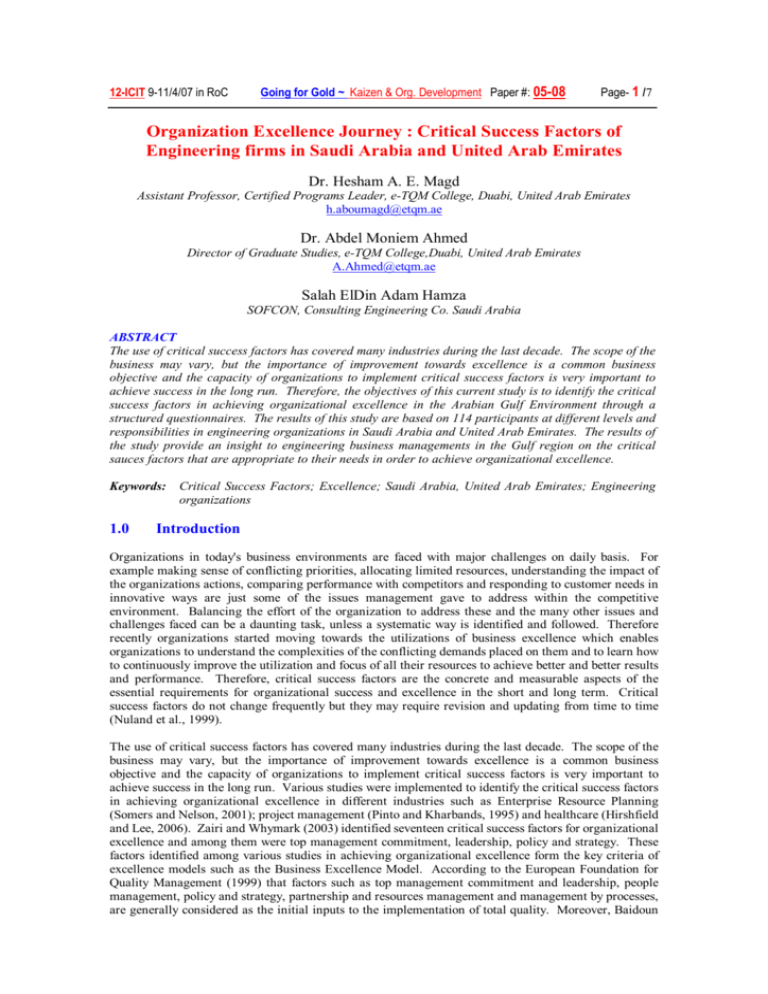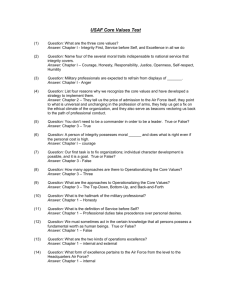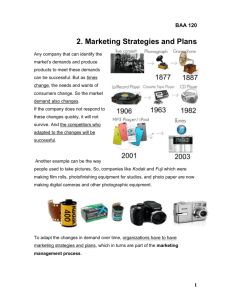Organization Excellence Journey : Critical Success Factors of
advertisement

12-ICIT 9-11/4/07 in RoC Going for Gold ~ Kaizen & Org. Development Paper #: 05-08 Page- 1 /7 Organization Excellence Journey : Critical Success Factors of Engineering firms in Saudi Arabia and United Arab Emirates Dr. Hesham A. E. Magd Assistant Professor, Certified Programs Leader, e-TQM College, Duabi, United Arab Emirates h.aboumagd@etqm.ae Dr. Abdel Moniem Ahmed Director of Graduate Studies, e-TQM College,Duabi, United Arab Emirates A.Ahmed@etqm.ae Salah ElDin Adam Hamza SOFCON, Consulting Engineering Co. Saudi Arabia ABSTRACT The use of critical success factors has covered many industries during the last decade. The scope of the business may vary, but the importance of improvement towards excellence is a common business objective and the capacity of organizations to implement critical success factors is very important to achieve success in the long run. Therefore, the objectives of this current study is to identify the critical success factors in achieving organizational excellence in the Arabian Gulf Environment through a structured questionnaires. The results of this study are based on 114 participants at different levels and responsibilities in engineering organizations in Saudi Arabia and United Arab Emirates. The results of the study provide an insight to engineering business managements in the Gulf region on the critical sauces factors that are appropriate to their needs in order to achieve organizational excellence. Keywords: 1.0 Critical Success Factors; Excellence; Saudi Arabia, United Arab Emirates; Engineering organizations Introduction Organizations in today's business environments are faced with major challenges on daily basis. For example making sense of conflicting priorities, allocating limited resources, understanding the impact of the organizations actions, comparing performance with competitors and responding to customer needs in innovative ways are just some of the issues management gave to address within the competitive environment. Balancing the effort of the organization to address these and the many other issues and challenges faced can be a daunting task, unless a systematic way is identified and followed. Therefore recently organizations started moving towards the utilizations of business excellence which enables organizations to understand the complexities of the conflicting demands placed on them and to learn how to continuously improve the utilization and focus of all their resources to achieve better and better results and performance. Therefore, critical success factors are the concrete and measurable aspects of the essential requirements for organizational success and excellence in the short and long term. Critical success factors do not change frequently but they may require revision and updating from time to time (Nuland et al., 1999). The use of critical success factors has covered many industries during the last decade. The scope of the business may vary, but the importance of improvement towards excellence is a common business objective and the capacity of organizations to implement critical success factors is very important to achieve success in the long run. Various studies were implemented to identify the critical success factors in achieving organizational excellence in different industries such as Enterprise Resource Planning (Somers and Nelson, 2001); project management (Pinto and Kharbands, 1995) and healthcare (Hirshfield and Lee, 2006). Zairi and Whymark (2003) identified seventeen critical success factors for organizational excellence and among them were top management commitment, leadership, policy and strategy. These factors identified among various studies in achieving organizational excellence form the key criteria of excellence models such as the Business Excellence Model. According to the European Foundation for Quality Management (1999) that factors such as top management commitment and leadership, people management, policy and strategy, partnership and resources management and management by processes, are generally considered as the initial inputs to the implementation of total quality. Moreover, Baidoun 12-ICIT 9-11/4/07 in RoC Going for Gold ~ Kaizen & Org. Development Paper #: 05-08 Page- 2 /7 (2003) indicated that in these models of excellence, essentially customer satisfaction, employee satisfaction and a favourable impact on society are achieved through leadership driving and strategy, people partnership, resources and processes, which lead ultimately to excellence in business results. Kanji and Tambi (1999) indicated that it is clear for a company to achieve business excellence, it is necessary for them to adopt a TQM process and the critical success factors which provide the core elements of excellence. In support of this further, Kanji (2000) confirmed a solid relationship exist among the identification of critical success factors and organizational excellence. However organizational excellence has become a subject of focus in many developing countries, including the Gulf Region. The literature review offers many diverse opinion concerning organizational excellence critical success factors in different countries but little empirical research has been carried out in the Gulf region. Therefore, it is important to study the critical success factors in achieving organizational excellence in order to enhance organizational excellence within the context of Engineering organizations1. The results of this study are useful for further improvements and economical development within the Gulf region. 2.0 Background The booming engineering sector in the Gulf region is faced with performance constraints at scheduling, workability and constructability aspects. Recently, governmental agencies have tried to bridge local engineering firms' shortcomings by allowing and encouraging alliances and affiliations with international organizations. This concept is perceived to strengthen local engineering firms and enhances their efficiency to deliver engineering projects of international level. Several approaches and techniques were utilized and proved their usefulness and have boosted engineering projects management efficiency dramatically, but it is important to identify a set of critical success factors to suit the needs of engineering firms in achieving organizational success and excellence. The identification of critical success factors early enough during the front end assessment of engineering projects is a vital start for ensuring successful project completion (Trop et al., 2005). Trop et al. (2005) identified eleven critical success factors for large public projects in Norway and they were project organization, contract strategy, project planning and controlling, stable framework and conditions, stakeholder management, technical factors, nature and market conditions, objective management, top management support, interface towards surrounding projects and management of design. This study is in line with Morris and Hughes (1987) findings, with the exception of an extra factor identified by Trop et al. (2005) which is contract strategy. Moreover, Pinto and Slevin (1987) identified various critical success factors and they included project mission, top management support, project planning, client involvement, personnel, technical activities, client acceptance, monitoring and feedback, communication, and trouble shooting. Furthermore, Havaleschka (1999) recommended various critical success factors in achieving competitive engineering design and they are leadership and commitment, people management, employee involvement, training and education, reward and recognition, teamwork, communication, supplier management, and customer satisfaction. While other critical success factors identified were project mission, project management, top management support, training, planning and scheduling, power and politics, customer communication, information technology, personnel, urgency of the project, technical resources, monitoring and feedback, internal communication, leadership and employee empowerment (King, 2001; Anderson et al., 2002; Davies, 2002; and Westerveld, 2003). These factors will help project teams to minmize fire fighting, intuitive approach in managing uncertainties and changes encountered during project implementation (Pinto and Kharbanda, 1995). The measurement of successful project implementation is not the avoidance of problem but knowing, beforehand as much as possible, how to respond when problem develops. Pinto and Slevin (1988) developed the notion of success and presented three key factors for successful project completion and they are technical validity, organizational validity and organizational effectiveness. Iyer and Jha (2005) concludes that the important success attributes are effective monitoring and feedback by the project manager and project team members, coordinating ability and relationship of project manager with top management, positive attitude of project manager, and project participants, and project managers' 1 Engineering firms are those organizations dealing with preparation of design drawings, materials and equipment specifications, procurement and construction packages for all type of projects in the fields of infrastructure, oil and gas, water supply and wastewater treatment plants, petrochemicals, residential and commercial buildings, etc. 12-ICIT 9-11/4/07 in RoC Going for Gold ~ Kaizen & Org. Development Paper #: 05-08 Page- 3 /7 technical capability. On the other hand, failure attributes were poor human resource management and labour strike, negative attitude of project manager and project participants, inadequate project formulation in the beginning, vested interest of client representative in not getting the project completed in time, and conflicts between project manager and top management (Iyer and Jha, 2005). It is clear that the identified critical success factors within the context of engineering project management are shifting from purely technical aspects into organizational aspects such as top management support, organizational issues, stakeholder management, coordination and human relations. The literature shows the availability of different critical success factors, but it lacks the provision of a specified set of critical success factors applicable to the needs of the engineering firms in the Gulf region as these organizations are facing difficulties to meet external customer requirements. Therefore, the main objective of the current study is the identification of appropriate critical success factors to engineering firms in order to enhance their performance and excellence. 3.0 Research methodology To identify the appropriate critical success factors in achieving organizational excellence, a survey questionnaire was used among a sample of Engineering firms in Saudi Arabia and the United Arab Emirates. The utilization of this approach permits use of large samples of respondents, provides highly specific and precise numerical data, results in high reliability and allows for generalization from the sample to the whole population. The questionnaires were developed based on an extensive review of the literature in the area of project management (King, 2001; Anderson et al., 2002; Davies, 2002; and Westerveld, 2003) in order to have a solid and reliable questionnaire. The survey questionnaires were distributed to a sample 256 participants. After two weeks from the time the questionnaire were distributed, only few answered questionnaires were returned. Reminder e-mails, telephone calls and verbal communications were utilized to persuade participants who have not responded to expedite their participation. Two more weeks late, more answered questionnaires were returned and the total responses reached 114, which represented a response rate of 44.5%. 4.0 Survey Findings and Discussion 4.1 Organizational characteristics In terms of experience in the engineering sector among the surveyed organizations, 76 of the participants had more than 10 years experience in the engineering industry, representing 66.67% of the surveyed sample. 5 – 10 years experience ranked second with 29 participants, representing 25.43% of the sample, followed by 3 – 5 (5.26%) years experience and 1 – 2 years (2.63%) as illustrated in table 1. Clearly the majority of the participants is highly experienced in the engineering industry and would have enough experience in identifying the appropriate critical success factors in achieving organizational excellence. In terms of ISO 9000 certification as illustrated in table 1, 92.11% of the surveyed organizations were certified, which indicates clearly that these organizations identified certification as an important aspect of their business in order to achieve an effective quality system in achieving quality products/services and also to enable them to export their products to the world and to fierce completion in the engineering sector. In terms of organizational size, it was important to determine the size classification for this study, therefore for the purpose of this study; organizations with less than 49 were classified small, those with 50 – 249 as medium, and those with more than 249 as large. With respect to the size of the organizations surveyed (see table 1), 10.53% had a staff less than 249 (Medium sized organizations) and 89.47% had staff of more than 249. It is clear that large sized firms constituted the largest portion of the surveyed organizations. Table 1: Characteristics of Surveyed Engineering Organizations (N=114) Activity Less than 1 year 1 – 2 years 3 – 5 years 5 – 10 years More than 10 years Number of Organizations Percentage of Organizations Experience in the Engineering Sector 0 0 3 2.63 6 5.26 29 25.43 76 66.67 12-ICIT 9-11/4/07 in RoC Going for Gold ~ Kaizen & Org. Development Paper #: 05-08 Page- 4 /7 Certification level ISO 9000 Certified Non ISO 9000 Certified 105 9 1 – 49 (Small) 50 – 249 (Medium) 250 or more (Large) 0 12 102 92.11 7.89 Organizational size 0 10.53 89.47 4.2 Critical success factors The present study suggested 15 possible critical success factors in achieving organizational excellence and participants were asked to rate the extent to which factor has helped the surveyed organizations the most in achieving organizational excellence. The rating was from very important for success to not important for success. The results are illustrated in table 2. By examining table 2, various critical success factors were identified. The most critical success factors contributed to organizational excellence within the surveyed organizations chosen based on high score (95% and above) and these factors are as follow: 1. Technical resources 2. Internal communications 3. Planning and scheduling 4. Project Management 5. Top management support 6. Leadership In terms of technical resources, it is clear that in order to attain knowledge needed to succeed; engineering firms must make sure that the technical resources are available. Engineers must have computers equipped with suitable engineering software to perform design, vehicles and transportation facilities to be able to have access to work sites whenever needed, office space to allow for resources expansions and meet urgency of the projects, etc. Hakserver (1996) claims that organizations have problems in implementing total quality management due to the lack of resources. Therefore as illustrated the availability of technical resources within engineering firms is vitally important in achieving excellence in engineering projects. Table 2: Critical success factors in engineering organizations Critical success factors Project mission Project management Employee leadership Training Planning and scheduling Power and politics Customer communication Information technology Personnel Urgency of the project Technical resources Monitoring and Very important 66 76 Important Count Count (%) Rank Neutral 3 3 Some importance 0 0 Not important 3 0 42 35 108 111 94.70 97.37 8 4 83 26 108 96.84 36 78 57 33 93 111 17 29 57 Count 6 3 6 12 0 3 15 81.58 97.37 13 3 6 3 9 0 3 0 18 3 46 40.35 15 29 21 18 98 51 108 94.70 9 6 0 0 6 26 70 96 84.21 12 9 6 3 18 81 24 27 48 108 72 94.70 63.15 7 14 6 24 0 9 0 9 6 42 84 30 114 100 1 0 0 0 0 42 63 105 92.10 10 3 6 0 9 12-ICIT 9-11/4/07 in RoC feedback Internal communication Top management support Employee empowerment Going for Gold ~ Kaizen & Org. Development Paper #: 05-08 Page- 5 /7 48 66 114 100 2 0 0 0 0 54 57 111 97.37 5 3 0 0 3 33 66 99 86.84 11 6 6 3 15 Internal communication was perceived as a critical success factor in achieving excellence as communication among teams, employees, and management is quite important to ensure that each member is aware of the various tasks, activities and problems associated with the projects, which in turn enable each member to participate with full knowledge of the current situation concerning the project at hand. This is supported further by Daft (1995) who indicated the importance of internal communication in achieving organizational success and suggested that internal communication is one important dimension in shaping organizational structure in addition to specialization, functional differentiation, professionalism, formalization, centralization, technical knowledge resources and administrative intensity. Planning and scheduling was another factor perceived to be important in the surveyed organizations in achieving organizational excellence. As this factor focus mainly on identifying various issues such as who should work in a project, which activities to do, how long each activity, what to use as input, what to deliver, at what cost, etc., are all questions considered and answered during the planning and scheduling stage. Therefore, improper handling of planning and scheduling never helps organizations to deliver their final product on time at the anticipated costs. The results of this study is supported by Whittaker (1999) who indicated that planning is seen as one of the most common reasons for failure of information technology projects. Regarding project management factor, the current study revealed that project management is critical is achieving organizational excellence and is even more important than project mission. Excellent project management capability in engineering firms supports better defining project mission, performance targets, and delivery on time. This is supported further by Pinto and Slevin (1988). In terms of top management support, the surveyed sample indicated the importance of top management support in achieving organizational excellence where top management support is essential to have the required technical and human resources without delay and raise employees' morale if they feel that management is giving them enough support. Ives and Olson (1984) support the current study as they identified the critical role of top management support within their study. Leadership was identified as an important critical success factor within the current study where organizational excellence depends on effective leadership of employees leading design teams through deploying management practices, implementing lessons learned, solving design and staff problems and presenting innovative ideas to customers and to managements. In support of this, Braga (2003) indicated that leadership must be exercised in order to develop the systems, tackle problems that may be faced at the beginning and ultimately make them culturally acceptable within the organization. In this context, they pointed out that leadership roles are creating the environment for change, showing the need for change, forming the leadership team, breaking down functional unfairness, creating the vision and strategy and creating team accountability for cross functional strategic themes at all organizational levels. The study revealed that the above six critical success factors are quite crucial for achieving organizational excellence, however the study also identified other factors which can be recognized for their importance and contribution towards achieving organizational excellence, and these factors are personnel, project mission, customer communication, monitoring and feedback. These factors are supported by CookeDavis (2002) who identified similar factors in achieving projects success in Europe. However, it is surprising to see that urgency of the project and power and politics ranked at the bottom of the table 2 of the critical success factors for achieving organizational excellence. Power and politics ranked at the bottom of the critical success factors and indicated that they have no significant effect on organizational excellence within the surveyed sample and these results differ from the results of Pinto and Slevin (1988) that indicated the importance of power and politics in achieving organizational success. However the variations within the current study might be due to the fact that organizational structure within the engineering firms is based on different nationalities of the workforce and it would be impossible to impose such a factor. Moreover, the urgency of the project was the second lowest success factor in the 12-ICIT 9-11/4/07 in RoC Going for Gold ~ Kaizen & Org. Development Paper #: 05-08 Page- 6 /7 study and this might be due to the fact that engineering employees do not have concerns whether the project is urgent or not and their productivity remains the same in all cases. However, from top manage perspectives, the picture may look different, top management may realize that an effort has to be made in order to raise productivity and get a project accomplished in a rush schedule. This can be accomplished through asking employees to work overtime or obtain more resources and in this case top management support is crucial in achieving the requested objectives. In examining table 2, the researchers classified the various identified critical success factors into different tiers as illustrated in Figure 1, where tier 1 (Technical resources; Internal communications; Planning and scheduling; Project Management; Top management support; and Leadership) is crucial to organizational excellence, tier 2 (Personnel; Project mission; Customer communication; Monitoring and feedback; Employee empowerment; Information technology and Training) is intermediate crucial level and tier 3 (urgency of the project; and Power and politics) is the lowest level. Figure 1: Critical Success factors Classification 100 Percentages 50 0 1 Tier 1 98.15 Tier 2 89.83 Tier 3 51.75 Critical Success Factors groupings In comparing the current study with previous studies, it is fair to illustrate that the current study is highly supported with previous studies but the only differences is that the ranking of the different critical success factors is different among studies and this is could be due to the variations of culture, where the selected ranking of the critical success factors within the current study is based on the traditional critical factors rather than the focus of the humanistic aspects of organizational excellence and therefore this might be an area where these engineering firms need to improve and focus on in the near future. 5.0 Conclusion There are various reasons available as to why construction projects are often completed late and significantly over budget. But all the more recent reviews agree that a significant contributory factor is the tendency for a poor relationship to exist between construction firms, Engineering firms and their clients and between contractors, sub-contractors and suppliers. This is attributed in part to clients placing too much stress on lowest price in awarding contracts. As a result some firms have priced work unrealistically low and then sought to regain their profit margins through contract cost variations arising from, for example design changes and other claims leading to disputes and litigation. Therefore identifying and determining critical success factors is believed to help alleviating engineering firms from their endurable problems and would enable them to achieve organizational excellence. Through the research, several critical success factors were identified within the sample in Saudi Arabia and United Arab Emirates and they included technical resources, internal communication, planning and scheduling, project management, top management support, and leadership. These identified factors within the surveyed sample seem to focus on the traditional factors without paying much attention to the importance of the soft factors such as training and empowerment as it does not matter how much your workforce is 12-ICIT 9-11/4/07 in RoC Going for Gold ~ Kaizen & Org. Development Paper #: 05-08 Page- 7 /7 motivated and skilled, it is important to utilize various techniques from the soft factors in order to enhance the motivations of your workforce and maintain them. References Anderson, E. S., Dyrhaugb, O. X., Jessena. S. (2002), "Evaluation of Chinese projects and comparison with Norweigan Projects", International Journal of Project Management, No. 20, pp. 601-609. Baidoun, S. (2003), "An empirical study of critical success factors of TQM in Palestinian organizations", Logistics Information Management, Vol. 16, No. 2, pp. 156-171. Cooke-Davies, T. (2002), "The real success factors on projects", International Journal of Project management, Vol. 20, pp. 185-190. Davies, T. C. (2002), "The real success factos on projects", International Journal of Project management, Vol. 20, pp. 185-190. Havaleschka, F. (1999), "Personality and leadership: a benchmark study of process and failure", Leadership and Organization Development Journal, Vol. 20, No. 3, pp. 114-132. Hirshfield, M. and Lee, P. D. (2006), "Critical Success Factors for Healtcare software implementations", www.getvitalized.com, accessed 28th September 2006. Ives, B. and Olson, M. H. (1984), ""User involvement and MIS success: a review of research", Managemtn Science, Vol. 30, No. 5, pp. 586-603. Iyer, J. C., and Jha, K. N. (2005), "Factors affecting cost performance: evidence from Indian construction projects", International Journal of Project Management, Vol. 23, pp. 283-295. Kanji, G. (2000), "Take a test drive for business excellence", Annual Quality Congress, Indianapolis, IN, Vol. 54, No. 0, May, pp. 377-385. Kanji, G. and Tambi, A. (1999), "Business excellence through customer satisfaction", Total Quality Management, Vol. 10, No. 1, pp. 129-153. King, T. Y. (2001), "The critical success factors that influence organizations to adopt internet technology", Malaysian Journal of Library and Information Science, Vol. 6, No. 2, pp. 35-51. Nuland, N. Y., Broux, G., Grets, L., De Cleyn, W., Legrand, J., Majoor, G. and Vleminckx, G. (1999), Excellent: A guide for the implementation of the EFQM Excellence Model, Comatech, Blanden. Pinto, J. and Kharbanda, O. P. (1995), Successful project managers: Leading teams to success, New York, van Nostrand Rheinhold. Pinto, J. K. and Slevin, D. P. (1987), "Critical success factors in successful project implementation", IEEE Transactions on Engineering Management, Vol. 34, No. 1. Pinto, J. K. and Slevin, D. P. (1988), "Critical succes factors across the project life cycle", Project Management Journal, Vol. 10, No. 3, pp. 67-75. Somers, T. M. and Nelson,K. (2001), "The impact of critical success factors across the stages of enterprise resources planning implementation", Proceedings of the 34th Hawaii International Conference on Systems Sciences (HICSS 34), Jan 3-6, Maui, hawaii. Trop, O., Austeng, K. and Mengesha, W. J. (2005), "Critical success factors for prject performance: A study from front end assessment of large public projects in Norway", www.concept.ntnu.no, accessed on 19th Nov 2006 Westerveld, E. (2003), "The project excellence model, linking success criteria and critical success factors", International Journal of Project Management, No. 21, pp. 411-418. Zairi, M. and Whymark, J. (2003), Best practice organizational excellence, e-TQM Publishing House, Dubai, United Arab Emirates






